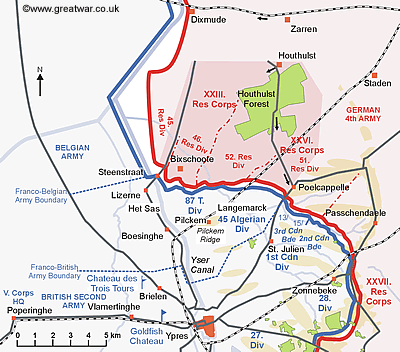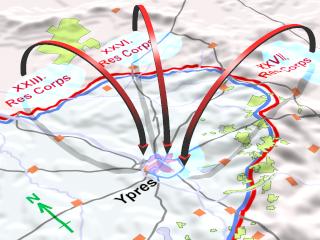 Allied activity during the morning and early afternoon
Allied activity during the morning and early afternoon
22 April 1915
A Zeppelin Heard in the Early Hours
At 2.50am a German Zeppelin airship was heard to fly in a north-westerly direction over the front lines. This was reported at 6.25am to the 1st Canadian Division headquarters at the Chateau des Trois Tours near Brielen. The message was received by the headquarters at 7am.(1)
The Weather

The dawn of Thursday 22nd April had brought with it a warm, sunny spring day.
Air Activity
German planes were seen making reconnaissance flights but there was no sign of Allied aircraft chasing them off.
At about noon a report was received at 1st Canadian Division headquarters and French 45th Division headquarters from the British V. Corps. In the early morning around 6am Allied air reconnaisance had discovered considerable activity behind the German lines and in the Houthulst Forest area, about 3 kilometres north of Langemarck. A German battalion was seen to be breaking bivouac at Houthulst village.
A 1/2 kilometre long column of German troops was seen to be on the march moving south on the Poelcappelle-Houthulst road with the head of the column at Poelcappelle station.
Troops moving in the south-east corner of Houthulst Forest had been seen and had tried to evade observation. A steam train on the Zarren to Dixmude line shut off steam when the Allied aeroplane appeared.
But there was nothing abnormal in this.
German Artillery Fires on Ypres

During the morning German 17-inch and 8-inch howitzers and lighter guns shelled Ypres. Towards midday the roads leading into the town were also fired on. The artillery fire gradually ceased from the German guns and the area became quiet again in the early afternoon.
Changes Observed in the German Front Line: Gas Pipes are Spotted
Already on the morning of Tuesday 20th April Captain Rae of the 16th Canadian Scottish Battalion had reported that the enemy's parapets had changed around during the night. Openings had appeared at regular intervals. Something seemed to be going on on the other side of no-man's-land. It may well have been the sitings of the gas cylinders that Captain Rae saw.
On the left wing of the 1st Canadian Division both the 13th and 15th Canadian Battalions reported on 22nd April to divisional headquarters that pipes were seen to be projecting through the German parapets on the other side of no-man's-land.
Mouth Organs and Playing Cards
In response to a request by the 3rd Canadian Infantry Brigade for some mouth organs and playing cards for the men in the front line, the generally quiet, routine nature of the day before 5pm is epitomized in this message from 1st Canadian Division headquarters:
“To 3rd Canadian Infantry Brigade
22 April 1915
There are one hundred mouth organs at divisional HQ for you aaa Please call for them aaa No cards available just now but will send you some out of next consignment.
From 1st Canadian Division 2.45 pm.” (2)
Next>> A favourable wind begins to blow
Acknowledgements
(1) Official History of the Canadian Forces in The Great War 1914-1919, Appendices, no. 338, p. 238
(2) Official History of the Canadian Forces in The Great War 1914-1919, Appendices, no. 339, p. 238